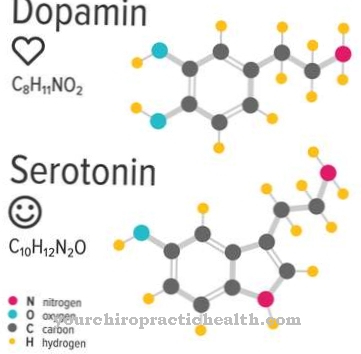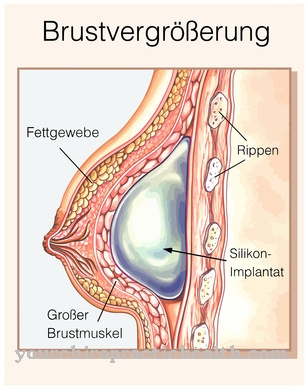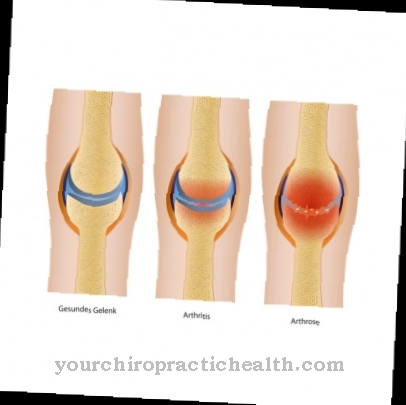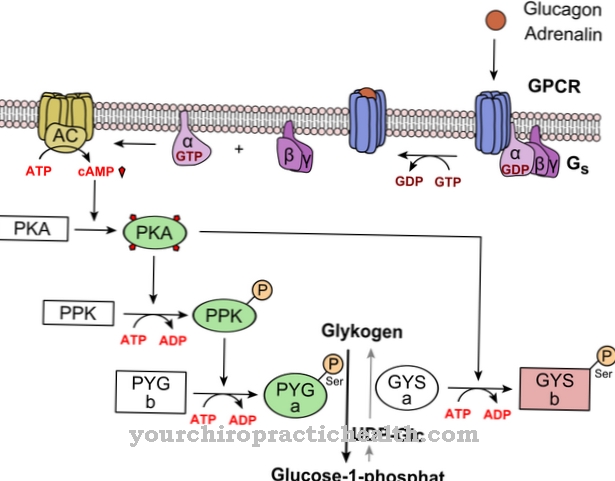The tracheo-oesophageal fistula connects the windpipe with the esophagus, causing symptoms such as coughing fits and food aspiration. The phenomenon is usually congenital and in this case is usually associated with a malformation of the trachea and esophagus. The treatment is performed surgically.
What is a tracheo-oesophageal fistula?

© pixdesign123 - stock.adobe.com
Fistulas are tubular connections between hollow organs or the body surface and an organ. These junctions correspond to pathological ducts surrounded or lined with tissue. In principle, fistulas can form in a wide variety of locations.
The tracheo-oesophageal fistula corresponds to a fistula connection between the trachea and esophagus, i.e. between the trachea and esophagus. Fistula connections between these two structures can exist in congenital or acquired form. Depending on the anatomical course, medicine differentiates between different forms of tracheo-oesophageal fistula.
One of these is the tracheo-esophageal fistula on the blind sac of esophageal atresia, which leads into the trachea and causes constant swallowing. H-fistulas, on the other hand, are connections between the esophagus and trachea that do not interfere with the passage of the esophagus.
Depending on its size, this congenital fistula leads at most to the aspiration of fluid while drinking: A tracheo-oesophageal fistula of the tracheal system, which leads into the lower blind sac of the esophageal atresia, is usually associated with gastric reflux and usually causes the most serious symptoms.
causes
Fistulas between the esophagus and trachea, like all other fistula connections, often occur after surgical complications. The infiltrative growth of malignant tumors can also be involved in the development. Basically, acquired fistulas between the esophagus and trachea are a rather rare phenomenon.
In less than one percent of those affected, a previous tracheostomy is the cause of the fistula duct formation. In around five percent of cases, the formation of the fistula is preceded by malignant esophageal tumors. Less than one percent of patients have primary lung tumors. The causes mentioned so far relate exclusively to the acquired form of the tracheo-oesophageal fistula. Depending on the cause, the acquired forms show a clinically diverse symptom picture.
In the vast majority of all cases, tracheo-oesophageal fistulas are congenital. Such congenital anomalies are usually related to malformations of the esophagus or trachea and rarely occur as isolated phenomena. A congenital fistula between the esophagus and windpipe occurs in about one or two newborns in between 2000 and 4000 live births.
The additional malformations affect up to 70 percent of the patients. In the context of superordinate syndromes, the fistulas are, for example, in the context of Feingold's syndrome or beta blocker embryopathy.
Symptoms, ailments & signs
Patients with a tracheo-oesophageal fistula show different symptoms depending on the location and cause of the fistula formation. With causes such as esophageal atresia, the clinical symptoms are determined by the atresia. If the duct of the fistula corresponds to an isolated fistula, coughing attacks occur which are symptomatic and associated with chronically recurrent aspiration pneumonia and meteorism.
The patients suffer from inflammatory reactions of the lungs, as stomach contents reach the lungs through their trachea. In addition, those affected often show high amounts of air in the digestive tract, because the connection between the esophagus and trachea facilitates air swallowing.
In addition to these symptoms, the fistula ducts between the two anatomical structures can also manifest themselves as refusal to drink and blue discoloration during an attempt to drink.In addition to recurrent aspiration of fluid and food, upper lobe atelectasis can occur.
Diagnosis & course of disease
The diagnosis of a tracheo-oesophageal fistula is made through imaging. In the case of congenital fistulas in this location, the doctor usually initiates the imaging in response to the refusal to drink or constant coughing fits. H-fistulas are localized starting from the trachea, especially from the level of the sixth to the second of the spine.
This means that these types of fistula are significantly higher than those of esophageal atresia. In all cases, evidence is provided by means of x-rays, which are carried out with fluoroscopy with administration of contrast medium. The exact localization determines the classification into one of the sub-forms. The prognosis of patients with tracheo-oesophageal fistulas depends on the exact location of the fistula and the primary cause of the duct formation.
Complications
First and foremost, those affected with this disease suffer from a very strong and above all unpleasant cough. This leads to coughing attacks that can significantly limit the everyday life of the person affected. Inflammation and infections in the lungs also occur and have a negative effect on the patient's quality of life.
Many sufferers choke on it, so that the air gets into the digestive tract. This leads to gas and flatulence. In the worst case, aspiration can also lead to the death of the patient. Ingestion can be fatal, especially in children. Since this disease does not self-heal itself, patients are always dependent on treatment by a doctor.
Usually, the treatment can be carried out through surgery. This takes place without complications and eases the discomfort enormously. There are no further complaints. Inflammations and infections are treated with the help of medication. As a rule, successful treatment does not reduce the patient's life expectancy. However, surgical treatment only takes place once the inflammation has been treated.
When should you go to the doctor?
In the case of repeated coughing attacks or an increase in coughing, the cause should be clarified. These are warning signals from the organism, the cause of which should be determined. If food keeps getting into the windpipe, if the person concerned chokes frequently or if vomiting occurs involuntarily, a medical examination is required.
Refusal to eat and drink fluids are considered worrying. A doctor must be consulted as a life-threatening condition can result. An increased body temperature, inner restlessness and irritability indicate a health impairment. If there are breathing noises, problems with the air supply or anxiety, a doctor must be consulted.
Disorders of the digestive tract, flatulence or swelling in the abdomen are further signs of an existing disease. Extensive medical examinations should be initiated if the person concerned suffers from ingestion of air, a decrease in exercise capacity and insomnia.
Medical care is indicated so that there is no further impairment of the quality of life. In acute situations there is a danger to life. Therefore, an ambulance service should be alerted if there is a shortage of breath, a state of unconsciousness or a panic attack. The person concerned threatens to die prematurely through suffocation. In these cases, those present must take first aid measures.
Treatment & Therapy
Treatment of a tracheo-oesophageal fistula depends on the primary cause. Symptomatic treatment of the fistula itself is equivalent to invasive surgery. During this procedure, the fistula duct is tied off. The connection between the esophagus and trachea is surgically separated and the two systems are made completely separate systems.
In addition to the actual treatment of the fistula, there is a causal therapy that tackles the cause of the problem. In the case of esophageal atresia, this causal therapy corresponds to an operation, before which the pent-up secretion is drained through a probe. The surgical correction consists of removing the upper part of the esophagus.
The loose parts of the esophagus are connected to one another after removal. If there is too great a distance between the individual parts, an alternative therapy is given. This therapy usually corresponds to an extension treatment of the esophagus that extends over several days or even weeks.
After the extension treatment, the distance between the two parts is ideally short enough to connect the ends. If the lengthening treatment does not give an adequate result, the surgeon relocates parts of the stomach or intestines to the chest area to replace the missing piece of esophagus.
The existing connections to the windpipe or lungs are severed and sealed tightly. All treatments of the tracheo-oesophageal fistula can only take place when there is no longer any active pneumonia.
You can find your medication here
➔ Medicines against coughs and coldsprevention
The tracheo-oesophageal fistula can only be prevented to the extent that oestrophaguatresia and other primary causes can be prevented.
Aftercare
After successful treatment of a non-congenital tracheo-osphageal fistula, regular follow-up examinations are required as the likelihood of recurrence of tracheo-oephageal fistula is increased in patients who have already had it. For this purpose, regular x-ray and, if necessary, MRI examinations of the esophagus and trachea should be carried out.
In addition, a doctor should be consulted immediately if severe heartburn, reflux (the belching of the stomach contents), frequent swallowing, especially when drinking, or breathing problems occur, as these can be signs of recurrence of a tracheo-oesophageal fistula. If the fistula developed as a complication of an operation, no further follow-up measures are necessary besides these controls.
If a tumor was the cause of the fistula formation, it is important to also check the blood regularly for tumor markers in order to detect the recurrence of a tumor at an early stage. If the tracheo-oesophageal fistula was congenital, regular examinations of the esophagus and windpipe should also take place during the course of the child's development, as the fistula can develop again in rare cases during adolescence.
In addition, in the case of a congenital tracheo-oesophageal fistula, any underlying genetic diseases that may lead to malformations (Feingold syndrome, VACTERL association) should be treated for life. Suitable therapies should be discussed individually with the attending physician.
You can do that yourself
A tracheo-oesophageal fistula must be surgically removed. The patient can support the treatment with a few measures and remedies from the household and nature.
First of all, the wound must be carefully cared for and observed after an operation so that complications can be identified at an early stage. If pain, bleeding or other unusual symptoms occur, the doctor should be informed. You should also speak to your doctor if there are signs of a relapse. The doctor can suggest suitable preparations or, in severe cases, prescribe ointments that require a prescription.
In addition, the cause of the development of the fistula must be determined. If the fistula appeared after an operation, comprehensive tumor prevention is always required. In particular with malignant esophageal tumors and primary lung tumors, the risk of tumor disease is relatively high.
Finally, rest and rest, as the operation and the removal of the fistula place greater stress on the body. The guidelines of the German Society for Pediatric Surgery provide those affected with further tips and information with which the tracheo-oesophageal fistula can now be treated effectively.



.jpg)




















.jpg)



